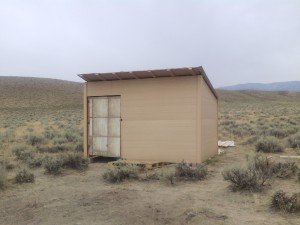This page may contain affiliate links. As an Amazon Affiliate, I earn on qualifying purchases. Please see our disclaimer for more information.
This is a post that was on my homesteading blog. Water harvesting is a new concept to me (keep reading to find out why) but something that we are now spending a lot of time planning.
When we moved to Wyoming from Oregon four years ago we had a bit of culture shock in some ways. While we knew that it rained considerably less here that in Oregon we were not prepared the difference it meant in many ways. I know that probably sounds pretty naïve but what we had taken for granted in water plentiful Oregon was very different here.
The first thing we noticed, water wasn’t readily available. In Oregon you could fill up a water jug at just about any service station for free. There would even be signs that said “Free Water” with a hose available. When we first moved here we were living in our camp trailer and even though our property had a well drilled on it we still needed to add a pump to be able to use the water. We could easily purchase filtered (expensive) drinking water in the grocery stores but cheap finding water for bathing and washing dishes was more of a challenge. There is a water station on the way in to town so one day we decided we’d better stop there and get some water. The water is fine for drinking and all use the cost was only 25 cents for 50 gallons. Win!
When I was a child my family used to have a water cistern and had to use a similar water station for our water needs. My dad had a big water tank in the back of his pick up truck and would stop and pick up water as needed to keep the cistern from running dry. My childhood memories of it made it seem like an easy task. So Joe and I put some water worthy containers in the bed of our pick up truck (we did not own a large water tank) and moseyed down to the water fill station.
My job was to put the quarter in while he held the hose and carefully filled up each of the containers. What happened next was where things went crazy. I put in the quarter and the water came shooting out of the hose! It had so much force that Joe couldn’t hold on to it and it was like a snake coiling through the air. He started ducking for cover and immediately yelled “turn it off! turn it off!” I hate to admit but it was such a funny show I could barely turn the water off through my laughing.
Joe was now soaking wet but our containers were still mostly empty. We decided to try it again since Joe now knew what to expect from the water hose. Take two did not go much better but we did manage to get more water in our containers than on Joe. Somehow I ended up wet also the second time around but Joe promised me it was an accident and the hose just slipped. The next day we found someone to come and get our well working. The well guy was even nice enough to put in a temporary pump until the one we needed arrived. That made things much easier!
At that time we weren’t familiar with the concept of harvesting rain water. If we had been then we would have been sitting pretty since there was a fair amount of rain during our water shortage.
Last year we finally started talking about setting up a collection system to collect the water off the roofs. And we are still talking about it. It is one of those things that keeps getting moved to the bottom of the list. Having the well has made us reliant on it and not seeing as much of a ‘need’ for the rain barrels. I’m often reminded though that when the power is out the well does not work. We’ve had the power go out twice in the past month and we’ve had to rely on our water storage during that time. It really is time to start getting the water collection in place!
Knowing that water will be scarce on our new property and that we won’t be putting in a well for at least two years we have been trying to learn all about harvesting water.
We even have an agreement that when we construct a building (of any size) it is not finished until the rain collection items are installed. It amazes me how little rain fall is needed to result in a large collection amount.
A 1000 square foot surface (roof) will produce over 600 gallons of water in a one inch rain. That means that in an area that receives ten inches of rain per year (the average where we are moving) we could collect 6000 gallons from one 1000 square foot area. That is pretty good. Joe is taking this pretty serious and my Mother’s Day gift this year was our first barrel for our new property. e will need several more collection containers and/or cisterns to collect the amount of water we need.
We plan to build a small shed as our first building. This will be where we stay when we go up there and then will eventually be used for storage. The roof line on this will be around 100 square feet so we won’t be able to capture a huge amount of rain water but it will be a good start. Here is a great example of a family that needed to capture water but didn’t really have the need for constructing another building. They made a simple shed roof specifically for water collection.
In addition to harvesting rain water off of the roof line, putting in a pond is a great way to harvest water. Joel Salatin talks a lot of this in his books. My first instinct with a pond would be to put it on low ground to capture the run off but Salatin suggests putting the pond on high ground. By putting it on high ground you can still capture the water but the big thing is using the water. On high ground gravity does the work for you and the water can be directed where it is needed. If the pond is on low ground a pump would be necessary to direct the water where needed. Here is an example of a pond that Salatin put in on his farm. In a future post it is indicated that it took two inches of rain to fill the pond. That is amazing to me since it is a BIG pond.
While the roof line collection and the pond are both great ways to harvest water we recently discovered information that takes water harvesting to a whole new level. Permaculture Designer Geoff Lawton has an amazing series of videos showing his permaculture designs. Water harvesting is the basis of most of these videos. I have to say the things he shows are quite amazing. His ideas of incorporating not just roof line collection and ponds but also swales is amazing. A swale (as near as I can tell) is essentially a drainage ditch. One either side of the ditch the soil is bermed and then heavily mulched. Trees (or as he calls it, a food forest) is planted on the berms. The beginning of this Youtube video gives an excellent example of the swales. There are many other videos put out by his group that share the same concept. And on his website he has full length videos showing how to incorporate permaculture in a property. I did have to put in my email address to view the videos but found them well worth it and have even watched a couple of them more than once and took notes.
All of this new knowledge on harvesting water is really enough to make my head spin. Our next steps will be to determine just what is feasible on our property and with our budget. I suspect there will be many future posts on this subject.
Update: The first weekend of November we went up to work on our new place. When we were there in early September we had set up a water collection system on our little shack. We put in a single gutter and downspout that went into a 55 gallon barrel. Right after we arrived at the property (for the November visit) the neighbor came over. I was chatting with him and told him I needed to go see if the water barrel had any water in it. He said something like, ‘no way will it have water this is the desert’. He was shocked when we went back to the barrel and not only was it full but overflowing. He couldn’t believe that the small amount of rain/snow over the previous two months had resulted in so much water. We used the water over the weekend for cleaning and miscellaneous things (not drinking) and still have a huge amount to empty out of the barrel before we left. We disconnected the barrel and put it up for the winter. I’m super happy with the results of our single barrel. Here is a picture of our little shack. It is only 100 square fee with a roof line only slightly larger (because of the overhang on the front). The barrel is in the back on the door side.
Photo: Picture from our 2012 trip to Multnomah Falls in Oregon












I never realized Wyoming was that dry. Looking at a map, I’m guessing the climate varies quite a bit across the state as a whole. When it comes to using the well, just how dry is it? Do you have to be careful to not overuse it?
Hi Kevin,
Where we currently live the official precipitation average is 13 inches per year. The new property we purchased at the beginning of summer (and will move to eventually) is 10 inches per year. Where we lived in Oregon was somewhere around 50 inches per year. Big difference!
We haven’t had any problem with our well but we did worry a little bit about it last year when we had a drought. We do have a rather slow well so we keep that in mind when using it. We don’t have a water harvesting system set up here but we do try to use our water wisely. When we clean out the goat and poultry water containers we reuse that water for the trees we’re attempting to grow.